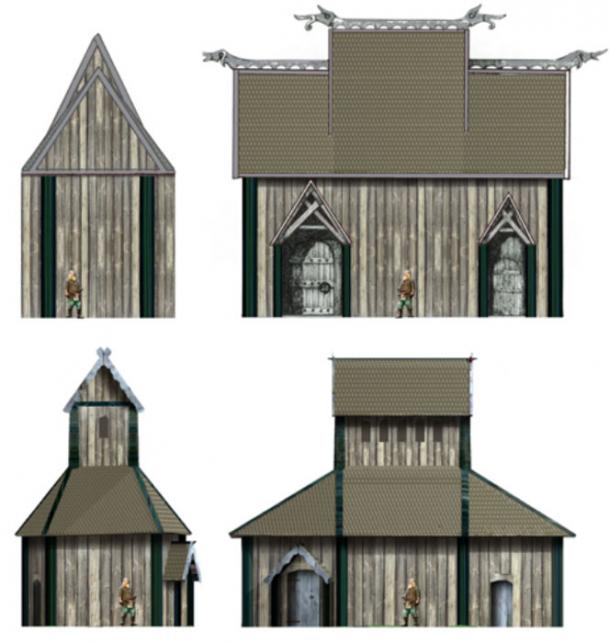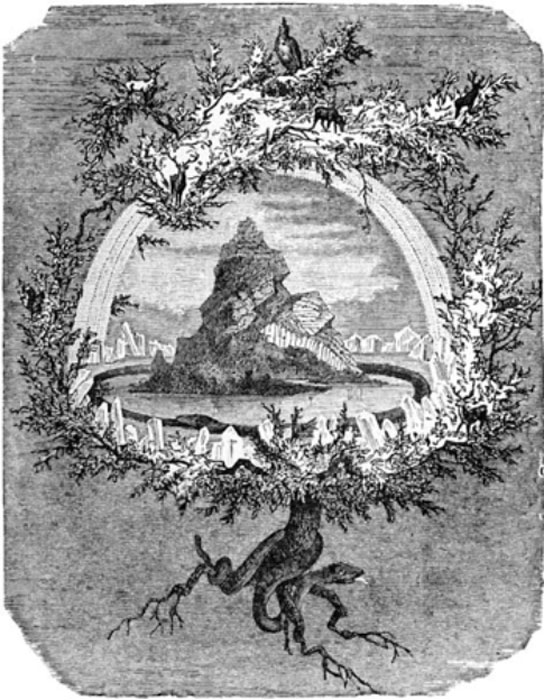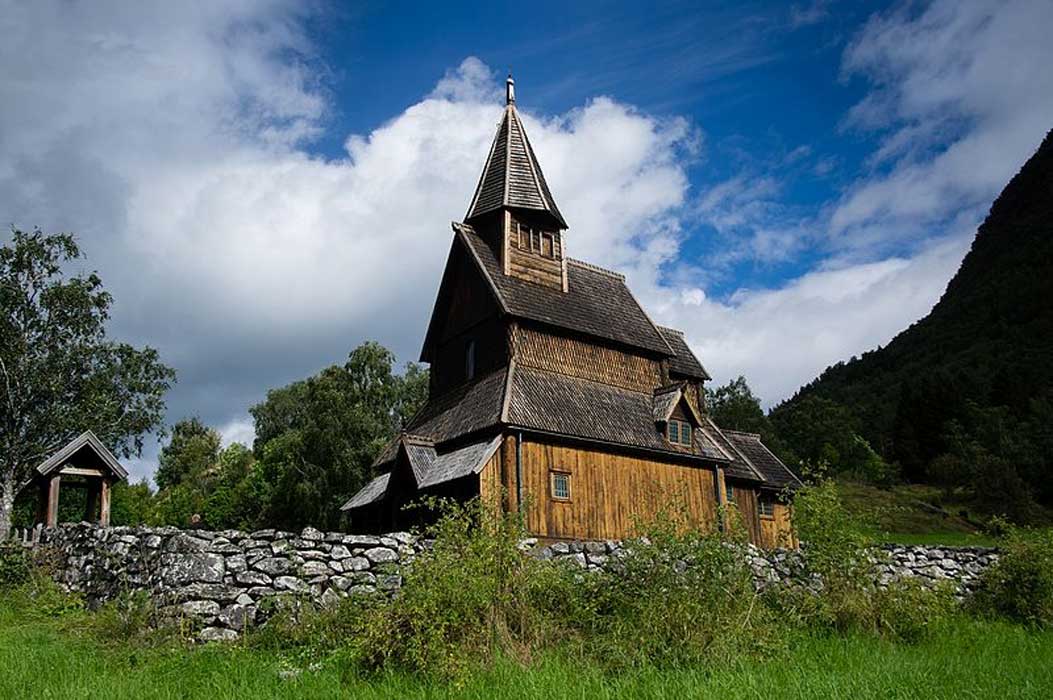Urnes Stave Church: A Final Vestige of Viking Innovation
At the edge of the world lies the last trace of Viking Christianity. Urnes Stave Church (c. 1130 AD) stands tall in Sognefjord in the west of Norway, yet it represents as much of an end as it does a new beginning. The church at Urnes is one of the last surviving examples of early Christian Scandinavia architecture, a rather lonely survivor which once had over 1300 siblings. Inspired primarily by the shipbuilding designs and pre-Christian mythology of the Viking culture, the northern architects of Urnes incorporated elements of Celtic and early Romanesque art. Interestingly, the method by which the Norsemen viewed these exterior artistic styles was due to those very same Viking ships.

Urnes Stave Church, Urnes, Norway, 12th century (CC BY 2.0)
During the early years of Christianity, particularly the 11 th century, there was a dramatic rise in church building due to the newly Christian leaders. But despite the new religion, the architects of the churches clung to the familiar. Though their attention to verticality was likely borrowed from early Romanesque influences in Britain, the Norse architects looked first to the pagan worship buildings called heathen hofs for the choice of post and lintel construction, and then to their powerful shipbuilding enterprise for the incorporation of dragon heads. Such images would have been familiar for worshippers of the new religion, and undoubtedly a comforting sight to the Scandinavians about to embark on a new Christian journey.
- The Royal Mounds of Gamla Uppsala, Ancient Pagan Site of Sweden
- Runes of Power and Destruction: Reading the Cursed Runestones of Sweden
- Archaeologists are Ecstatic that a Major Viking Age Manor is Finally Found in Sweden

Two reconstructions of the heathen hof at Uppåkra, Sweden. (CC BY SA 3.0)
Typical Timber Construction
Urnes Stave Church followed the typical construction of previous northern churches; they were constructed using a simple post and lintel design. In fact, the word stav is the Norwegian for "post." As with the majority of Scandinavian architecture, Urnes Stave church is made of timber, a readily accessible material in the area, though not conducive for longevity, as seen by the lack of other early medieval sites. Due to the architects' skills in shipbuilding, manipulating timber into this new form was an easy transition. Further, one can see evidence of marine influence in the interior of the stave churches. This, once again, is likely because the early Christian Norsemen borrowed from what they already excelled at architecturally: shipbuilding.

Interior, Urnes Stave Church, Ornes, Norway. (CC BY SA 4.0)
The interior roofs—as seen in Urnes, though shown here in the reconstruction of Borgund Stave Church (Borgund Stave Church is used in this article as both a comparative example and an illustration of the evolution of stave church architecture from its beginnings to its end.) —are essentially inverted ships, while on the exterior, carved dragon heads growl down from ridge crests. These heads are intended to recall to the viewer’s mind the warships that once terrorized the coastlines of new lands before making landfall and laying siege. According to scholar Olaf Olsen, there is no other source for the style of the stave churches except indigenous Norway itself, which lends credibility to their choice to incorporate ship designs. By the time Urnes Stave Church was constructed, however, incorporating dragon heads were no longer typical of church architecture, and the interior was more than a single room, following the Romanesque basilica blueprint. The serpentine dragon was replaced by positive symbolism of rebirth.

Borgund Stave Church roof interior, Borgund, Norway, 12th c. AD (Micha L. Rieser)
Vestiges of Norse Mythology
In Sturluson's Poetic Edda, the World Tree played one of the most important roles in the tale. Called Yggdrasil for its relationship to Odin, the World Tree spans the entirety of the universe: its leaves reach to the very heights of heaven and its roots touch the bowels of hell. Because of its interconnectedness, it is the only thing to survive Ragnarök, and it shelters the Adam and Eve of the Norse world: Lif and Lifsandir. Urnes Stave Church represents the best surviving example of the way in which rebirth was pertinent to the imagery of the new Christian structures. These new churches are the protectors of this new religion, just as Yggdrasil protected Lif and Lifsandir.
Looking at the north portal of Urnes Staves Church, the intertwining, interwoven vines and leaves are intended to be representative of Yggdrasil. The style of the portal is the Urnes style, which developed around 1050 AD—possibly in Sweden—but takes its name from this particular church. The branches are entangled in what appears to be disarray across the portal, however this was a standard aspect of Viking and early medieval art, more identifiable as Yggdrasil by the creature in the lower left corner. The Urnes technique is categorized by stylized animals, slimly interwoven into patterns. Animals have almond shaped eyes with their heads shown in profile, and tend to be curving in an upward fashion. These techniques are evidently seen on the Urnes portal as the serpent Níðhöggr is shown with the aforementioned almond eyes tightly twisting upward.

Urnes Stave Church north portal, Urnes, Norway, c. 1132 AD. (CC BY SA 2.0)
Celtic Influence
The Urnes style drew heavily from Celtic art, the twined animals and roots akin to the interlace prominent in Celtic manuscript art. Curvilinear and rectilinear lines existed as central motifs in Celtic art before, during and after the Roman Empire, and were particularly embraced during the La Tène period (400 BC-100AD). Interlace, on the other hand, first appeared in the villa of the Roman emperor Hadrian in the 2nd c. AD, as the border of a floor mosaic. The Celts adopted interlace and transformed it from a border to a focal piece, which eventually was translated into the Urnes style of Viking art due to their consistent raids of the British Isles in the early medieval period. The Urnes north portal reveals the way in which the late Viking style emphasized not only homegrown qualities, but also incorporated exterior influences to exemplify their version of the new Christian religion. The Celts, of course, had been converted to Christianity before the Norsemen.
- The Ancient Book of Deer, Oldest Known Gaelic Text in Existence
- The Viking Serpent: Secrets of the Celtic Church in Norway Their Serpent Worship and Sacred Pentagram Geometry
- Norwegian Archaeologists Have Found the Shrine of a Miracle-Making Viking King
Transitioning from Norse to Christian Stories
On the north porta, the interlace is utilized to blend Norse mythology with the new Christian stories, as followers would have recognized Níðhöggr as the pagan creature which gnawed on one of the roots of the Yggdrasil until the coming of Ragnarök, and as a metaphor for the serpent in the Garden of Eden. There are varying beliefs about the type of animal represented here is. While it appears to have four legs, depictions of Níðhöggr in medieval Icelandic texts tend to depict the serpent with fore and hind legs, like a combination of a deer and a snake, so it is likely that Níðhöggr is at least hinted at here. By depicting an animal from Hel steadily making his way through the root, the steady conquest of Christianity over paganism is evident. That the World Tree survives Níðhöggr's destructive endeavors would have been a powerful message of the new faith; such a depiction here—at the threshold of Christ's door—would have created a moment of physical acceptance of the new religion.

"The Ash Yggdrasil". The world tree Yggdrasil and some of its inhabitants. Wägner, Wilhelm (1886) (Public Domain)
Though Christianity’s hold on Scandinavia was strong following the reign of Olaf I and his successors, it was not possible for it to completely erase the old values and beliefs of the northern world. By creating churches and images that spoke of the twilight of the gods, the pagan apocalypse, Scandinavia—and Norway in particular—was able to make peace with the new faith in such a way that did not rob them of their old traditions. The stave churches are the best example of the way in which Christianity and paganism were able to co-exist, and the best visual example of how the two faiths were combined so the new faith could be understood. Ragnarök allowed the pagans a justification for their acceptance of the Christian god, a celestial end of the world rather than a literal one, their celestial world ends and is reborn, and the structure of the churches is intended to act as a physical representation of it.
Urnes Stave Church has undergone several alterations over the years, in the 17 th and 18 th centuries in particular. There is also archaeological evidence of previous post and lintel structures (likely pagan) on the same land. Thus, when described as an "early medieval church", this indicates that the church maintains aspects from the 11 th and 12 th centuries—the earliest record of this location being a Christian site.
Top image: Urmes Stave Church, Norway (CC BY SA 4.0)
By Riley Winters
References
Abram, Christopher. 2011 Myths of the Pagan North: The Gods of the Norsemen. Hambledon Continuum: US.
Aldhouse-Green, Miranda. 2002. "Any Old Iron! Symbolism and Ironworking in Iron Age Europe." In Miranda Aldhouse-Green and Peter Guest (eds.) Artefacts and Archaeology: Aspects of the Celtic and Roman World. Cardiff: University of Wales Press. 8-19.
Allan, Tony. 2004. The Vikings: Life, Myth and Art. Barnes and Noble: New York.
Batey, Colleen, Helen Clarke, R.I Page, and Neil Price. 1994. Cultural Atlas of the Viking World. Oxford Limited: Oxford.)
Bjerknes, Kristian and Robert Kloster. 1966. Borgund stavkirke: the stave church at Borgund. Bergen: Norway.
Davidson, H.R. Elllis. 1993. The Lost Beliefs of Northern Europe. Routledge: London.
Davidson, H.R. Elllis. 1998. The road to Hel; a study of the conception of the dead in Old Norse literature. Greenwood Press: New York.
DuBois, Thomas A. 1999. Nordic Religions in the Viking Age. University of Pennsylvania Press: Philadelphia.
Guest, Peter. 2002. "Manning the Defenses: The Development of Romano-British Urban Boundaries." In Miranda Aldhouse-Green and Peter Guest (eds.) Artefacts and Archaeology: Aspects of the Celtic and Roman World. Cardiff: University of Wales Press. 76-89.
Laing, Lloyd and Jennifer Laing. 1996. Art of the Celts. London: Thames & Hudson, Ltd.
Lincoln, Bruce. 1977 "Treatment of Hair and Fingernails among the Indo-Europeans," History of Religions, 16.4. pp. 351—362.
Mathews, Thomas. 1995. The Clash of Gods: A Reinterpretation of Early Christian Art. Princeton University Press, New Jersey.
Price, Neil. 2008. The Viking World. Routledge: London.
Sturluson, Snorri. The Poetic Edda. (trans. Lee M. Hollander, 2011.) University of Texas Press: Austin.
UNESCO. "Urnes Stave Church." UNESCO World Heritage Site. Accessed July 18, 2017. Available at: http://whc.unesco.org/en/list/58


















Comments
Wow, it looks amazing! Especially Urnes Stave Church in Urnes, Norway (12th century). I wish i could see all these beauties. I knew that Scandinavian countries are really very beautiful with all these mountains and lakes. But I did not know that they have retained these ancient and at the same time beautiful cultural attractions. So thank you for such an important information. I`m doing <a href="https://www.smartpaperhelp.com/" rel="nofollow">research paper help</a> so can i use some information given here in my paper? Hope you are not against. Thanks!